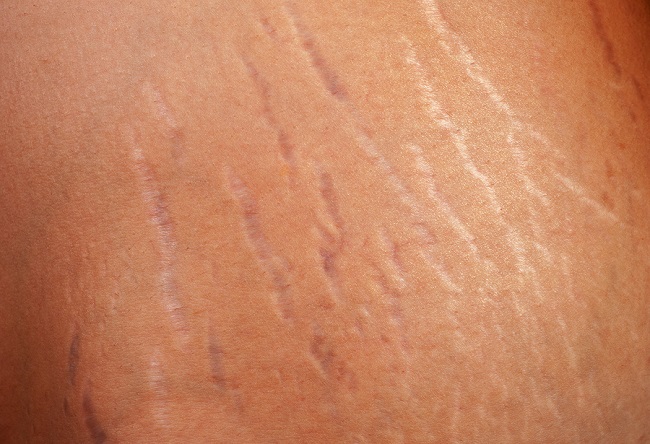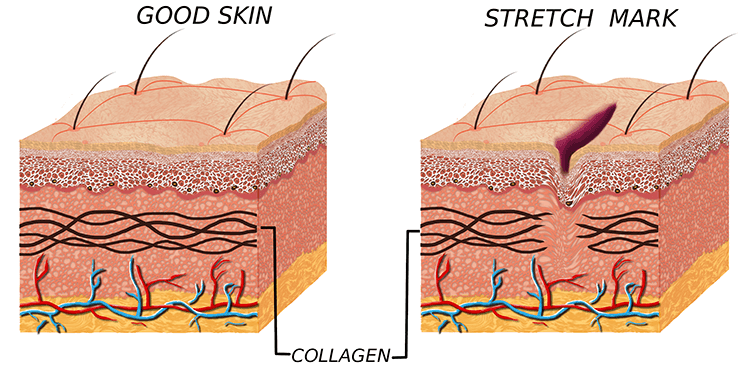Stretch marks, also known as striae, are a common skin concern that affects many people. These long, thin scars can appear on various parts of the body and can be caused by a variety of factors. In this blog post, we will discuss the causes of stretch marks and the available treatments for them.
Contents
- 1 Stretch Marks Are Scars
- 2 Cause: Weight Gain
- 3 Cause: Pregnancy
- 4 Cause: Medication
- 5 Cause: Medical Conditions
- 6 Can You Prevent Them?
- 7 See a Dermatologist
- 8 What May Help: Retinol Products
- 9 What May Help: Laser Therapy
- 10 What May Help: Self-Tanning Products
- 11 Not Likely to Help: Exfoliating
- 12 Not Likely to Help: Most Lotions and Creams
- 13 Video
- 14 Kết luận
Stretch Marks Are Scars

Stretch marks are a type of scar that forms when the skin is stretched beyond its normal capacity in a short period of time. This can happen during pregnancy, rapid weight gain or loss, or growth spurts in adolescence. The elastic fibers in the skin become damaged, resulting in long, thin scars that can range in color from pink to red to purple.
Where You Get Them
Stretch marks can appear almost anywhere on the body, but they are most commonly found where the body stores fat. This includes the belly, hips, thighs, breasts, and buttocks. They can also occur on the lower back or the backs of the arms. Genetics may play a role in the development of stretch marks, as individuals whose parents have them are more likely to develop them as well.
Anyone Can Get Them
While stretch marks are more commonly associated with women, men can also develop them. It is estimated that 50% to 90% of women have stretch marks, but they can also occur in men during periods of rapid growth or weight gain. Teenagers going through growth spurts may also experience stretch marks.
They Don’t Go Away
Unfortunately, stretch marks are permanent scars. However, over time they may fade and become less noticeable. They may appear white or silvery in color. While they may be a source of self-consciousness for some, it is important to remember that more than half of adults have stretch marks.
Cause: Weight Gain

One of the most common causes of stretch marks is rapid weight gain. When the body gains weight quickly, the skin may not have enough time to adjust and stretch accordingly. This can result in the tearing of the elastic fibers in the skin, leading to the formation of stretch marks.
What May Help: Maintaining a Steady Weight
The best way to prevent stretch marks caused by weight gain is to maintain a steady weight. This means avoiding rapid weight gain or loss, which can put stress on the skin. Eating a healthy diet and staying hydrated can also help keep the skin healthy and less prone to damage.
Cause: Pregnancy

Pregnancy is another common cause of stretch marks. As the baby grows, the skin on the belly stretches to accommodate the growing uterus. Hormonal changes during pregnancy can also affect the skin’s elasticity, making it more likely to develop stretch marks.
What May Help: Moisturizing and Proper Nutrition
While it is difficult to prevent stretch marks during pregnancy, keeping the skin well-moisturized and nourished can help. Drinking plenty of water and eating foods rich in zinc, vitamins A, C, and D can help keep the skin healthy and potentially reduce the appearance of stretch marks.
Cause: Medication
Some medications can cause weight gain, swelling, or other physical changes that can lead to stretch marks. Hormonal birth control pills and corticosteroids are two examples of medications that can contribute to the development of stretch marks.
What May Help: Talking to Your Doctor
If you are taking a medication that you believe may be causing stretch marks, it is important to talk to your doctor. They may be able to suggest alternative treatments or ways to manage the side effects of the medication.
Cause: Medical Conditions
Certain medical conditions can also make individuals more prone to developing stretch marks. These include conditions that cause weight gain, sudden growth, or skin problems. For example, Cushing’s disease and Marfan syndrome can increase the likelihood of developing stretch marks.
What May Help: Seeking Medical Advice
If you have a medical condition that may be contributing to your stretch marks, it is important to seek advice from a healthcare professional. They can provide guidance on managing your condition and potentially reducing the appearance of stretch marks.
Can You Prevent Them?
While genetics may play a role in the development of stretch marks, there are steps you can take to potentially prevent them. Maintaining a healthy weight, staying hydrated, and eating a balanced diet can all help keep the skin healthy and less prone to damage.
See a Dermatologist
If you are concerned about your stretch marks or want to explore treatment options, it is best to consult with a dermatologist. A board-certified skin specialist can assess your individual case and recommend the most effective treatments for your skin type.
What May Help: Retinol Products
Retinol, a derivative of vitamin A, has been shown to help reduce the appearance of stretch marks. It works by increasing cell turnover and promoting the growth of new skin. However, it is important to start using retinol products soon after stretch marks appear and to use them regularly for optimal results. Tretinoin, a type of retinol, is only available by prescription, so it is important to consult with a dermatologist before trying this treatment.
What May Help: Laser Therapy
Laser or light therapy is another option for reducing the appearance of stretch marks. This treatment triggers changes in the skin that can help blend the stretch marks with the surrounding skin. It is most effective for individuals with medium-tone skin. However, laser treatments can be expensive and may require multiple sessions to see results. It is important to seek treatment from a board-certified dermatologist or plastic surgeon who has experience working with your skin tone.
What May Help: Self-Tanning Products
Self-tanning lotions and sprays can help darken the appearance of stretch marks, making them less noticeable. This is especially effective for individuals with white or very light stretch marks. It may take some trial and error to find the right product and shade that works best for your skin.
Not Likely to Help: Exfoliating
While exfoliating treatments may claim to reduce the appearance of stretch marks, there is little evidence to support this. In fact, some dermatologists believe that exfoliating treatments, such as scrubs and microdermabrasion, may actually make stretch marks worse.
Not Likely to Help: Most Lotions and Creams
Many over-the-counter products claim to fade stretch marks, but there is limited evidence to support their effectiveness. These products may not be able to repair the damaged elastic fibers that cause stretch marks. Additionally, there is no evidence to suggest that using oils or cocoa butter during pregnancy can prevent stretch marks.
Video
Kết luận
Stretch marks are a common skin concern that can affect anyone. While they may be permanent, there are steps you can take to potentially prevent them and reduce their appearance. Maintaining a healthy weight, staying hydrated, and seeking advice from a dermatologist can all help in managing stretch marks. Remember, stretch marks are a natural part of the body and should not be a source of shame or insecurity. Embracing and caring for your skin is the most important thing.

